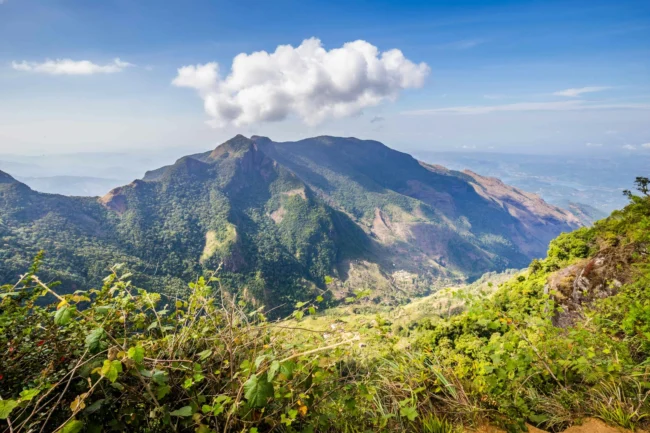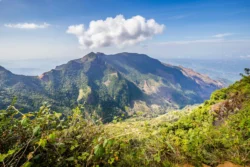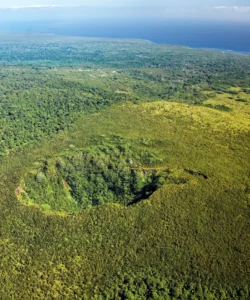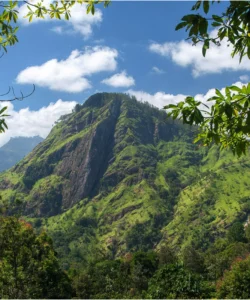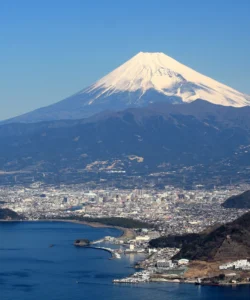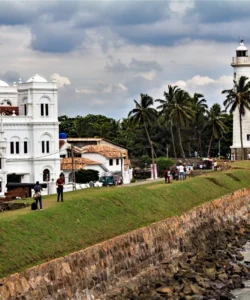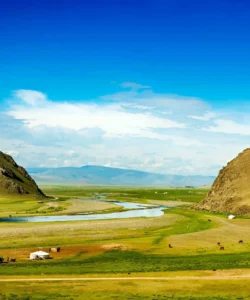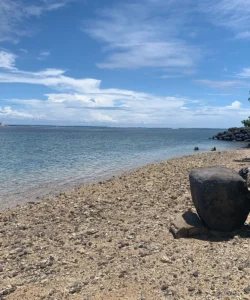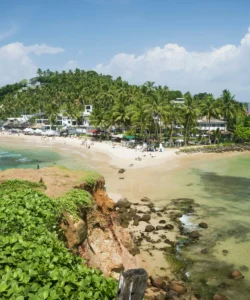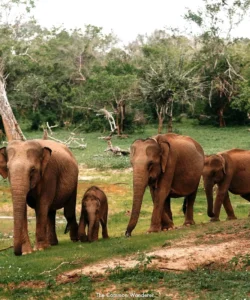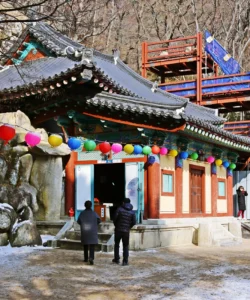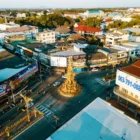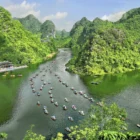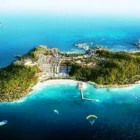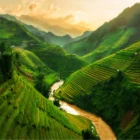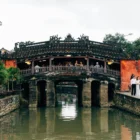Horton Plains National Park is a unique and captivating protected area located in the central highlands of Sri Lanka. Situated on a high-altitude plateau, it is characterized by sweeping grasslands, patches of cloud forest, and dramatic escarpments, most famously “World’s End,” a sheer cliff plunging hundreds of meters. A UNESCO World Heritage site (as part of the Central Highlands of Sri Lanka), Horton Plains offers a distinct trekking experience amidst a cool, misty environment, showcasing unique biodiversity and breathtaking panoramic views.
Name: Horton Plains National Park (හොර්ටන් තැන්න ජාතික උද්\u200dයානය)
Address: Nuwara Eliya District, Central Province, Sri Lanka. It is located about 32 km (20 miles) south of Nuwara Eliya town, between Nuwara Eliya and Haputale.
How to get there:
Reaching Horton Plains National Park typically involves first getting to Sri Lanka (Colombo) and then traveling into the highlands, often using Nuwara Eliya or Haputale as a base:
- From Colombo (CMB) to Nuwara Eliya or Haputale:
* Train + Taxi/Tuk-tuk (Recommended for scenery): Take a train from Colombo Fort Railway Station to Nanu Oya Station (for Nuwara Eliya) or Ohiya Station (closer to Horton Plains, but less frequent connections and fewer accommodation options). This famously scenic train journey through tea plantations takes 4-7 hours depending on destination. From Nanu Oya, it’s about a 1.5-hour drive by car/van or 1 hour by tuk-tuk to the park entrance. From Ohiya, it’s closer but remote.
* Bus: Direct buses are available from Colombo to Nuwara Eliya (5-6 hours) or Haputale (6-7 hours). From there, arrange a taxi or tuk-tuk to the park.
* Taxi/Private Car: Available from Colombo, taking about 4-5 hours to Nuwara Eliya or Haputale. - From Nuwara Eliya to Horton Plains:
- Early Morning Taxi/Van: This is the most popular and recommended way. Hire a taxi or van from Nuwara Eliya. It’s about a 1.5-hour drive (32 km) on sometimes challenging roads. Most visitors depart Nuwara Eliya around 5:00-5:30 AM to arrive at the park by its 6:00 AM opening, aiming to see World’s End before mist rolls in.
- Tuk-tuk: Possible but takes longer (around 1 hour one-way) and can be very cold, especially in the early morning.
- From Haputale/Ohiya to Horton Plains: Closer by distance, but often requires pre-arranged transport due to the remote nature of Ohiya.
Operating Hours and Entrance Fee:
- Operating Hours: The park is generally open daily from 6:00 AM to 6:00 PM. Visitors must exit by 6 PM. Entry tickets are usually sold until 2:30 PM.
- Entrance Fee: For foreign visitors, there is a per-person entrance fee (typically around $20-30 USD plus taxes and service charges, subject to change). There are also separate fees for the vehicle (taxi/van/tuk-tuk) and a mandatory tracker from the park. Note: Plastic items are generally not allowed inside the park.
Landscape and Architecture:
Horton Plains National Park’s “architecture” is its raw, high-altitude natural landscape:
- Rolling Grasslands and Montane Forests: The park is characterized by a mosaic of gently undulating “wet patana” (montane grasslands) interspersed with patches of stunted, moss-laden cloud forest. This creates a visually striking contrast and a unique ecosystem.
- World’s End: The most famous attraction. It’s a dramatic sheer cliff that plunges abruptly about 880 meters (2,890 feet) into the valley below, offering a dizzying, breathtaking panoramic view on clear mornings.
- Baker’s Falls: A beautiful, multi-tiered waterfall (around 20 meters / 66 feet tall) named after Sir Samuel Baker, integrated into the popular hiking trail.
- Mini World’s End: A smaller, but still impressive, cliff with a 300-meter drop, offering expansive views.
- Streams and Rivers: The plains are crisscrossed by a network of streams and channels. Horton Plains is a critical watershed, being the headwaters for three major Sri Lankan rivers: the Mahaweli, Kelani, and Walawe.
- Cloud Forest: The park contains the most extensive area of montane cloud forest remaining in Sri Lanka, which is often shrouded in mist, creating an eerie and mystical atmosphere. The trees are often gnarled and covered in mosses, lichens, and ferns.
- Peaks: Sri Lanka’s second and third highest mountains, Kirigalpoththa (2,395m) and Thotupola Kanda (2,357m), are located within the park’s boundaries, with trails leading to their summits (though the main World’s End trail is more popular).
- Hiking Trails: A well-maintained circular hiking trail (approximately 9.5-10 km / 6 miles) takes visitors to World’s End, Baker’s Falls, and through the diverse landscapes. This is the primary way to experience the park.
What makes it famous:
Horton Plains National Park is famous for:
- World’s End: Its spectacular, dizzying cliff viewpoint is its most iconic and famous attraction, offering unparalleled panoramic vistas.
- UNESCO World Heritage Site: Recognized for its exceptional natural beauty, biodiversity, and significant ecological processes as part of the Central Highlands of Sri Lanka.
- Unique High-Altitude Ecosystem: It’s the only national park in Sri Lanka situated entirely in the wet zone and at such a high altitude (2,100–2,300 meters), leading to a unique blend of montane grasslands and cloud forests.
- Endemic Flora and Fauna: Home to a high concentration of endemic species found only in Sri Lanka, and some even restricted to Horton Plains, including the Horton Plains slender loris, purple-faced langurs, sambar deer, and various endemic bird species (like the Sri Lanka whistling thrush and dull-blue flycatcher).
- Exceptional Hiking Experience: It offers a pristine and well-defined hiking trail that allows visitors to explore its diverse landscapes on foot, a unique feature among Sri Lankan national parks (most others are safari-based).
- Watershed Importance: It’s a crucial catchment area for many of Sri Lanka’s major rivers.
- Cool and Misty Climate: A refreshing escape from the tropical heat, offering a distinct climatic experience compared to the rest of the island.
Differences from some other wonders:
Horton Plains National Park distinguishes itself from other national parks and natural wonders in several key ways:
- High-Altitude Plateau & Cloud Forest Ecosystem: Unlike lowland safari parks (like Yala National Park) dominated by scrub or savanna, Horton Plains is an elevated montane plateau characterized by cool temperatures, frequent mist, and a unique cloud forest ecosystem. This distinct climate and vegetation type set it apart from other Sri Lankan parks.
- “Walkable” National Park: While many national parks are primarily for jeep safaris (e.g., Yala, Udawalawe), Horton Plains is Sri Lanka’s only national park where visitors can explore extensively on foot via well-marked circular trails. This offers a more intimate and immersive experience with the landscape.
- Dramatic Escarpments (World’s End): Its signature “World’s End” cliff, a sheer, dramatic drop, is a unique geological feature that provides a more thrilling and visually distinct “viewpoint” compared to the panoramic vistas from mountains or towers in other areas.
- Biodiversity of a High-Altitude “Island”: The high level of endemism among its flora and fauna, particularly species adapted to its specific montane cloud forest environment, makes it a unique biological hotspot within a geographically isolated setting.
- Emphasis on a Single, Iconic Trek: While other parks might have many trails, the circular World’s End and Baker’s Falls trail is such a defining and iconic experience that it is almost synonymous with a visit to Horton Plains, offering a very focused and rewarding trekking journey.
- No Plastic Policy: The strict ban on single-use plastics within the park is a unique and commendable environmental policy that distinguishes its management and visitor experience.
In essence, Horton Plains National Park is a sublime and unique wonder, offering a captivating journey through a misty, high-altitude wilderness, culminating in breathtaking vistas from the edge of the world, making it an unforgettable highlight of Sri Lanka’s central highlands.
